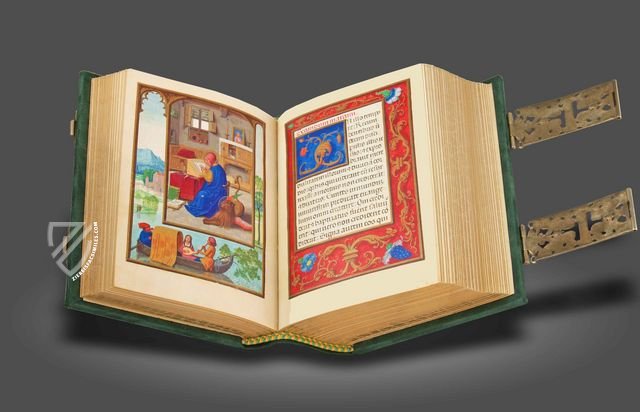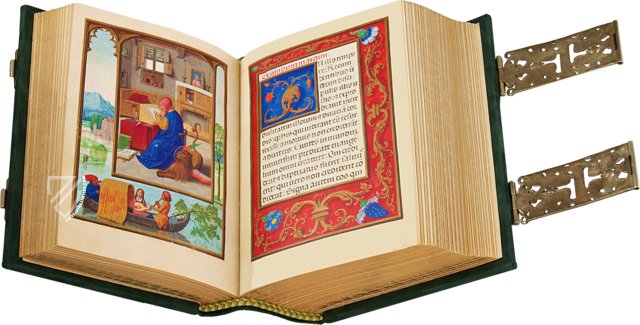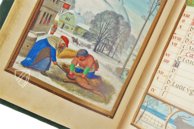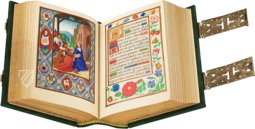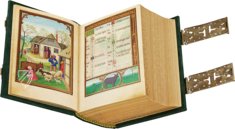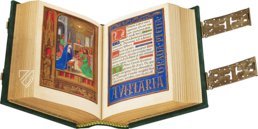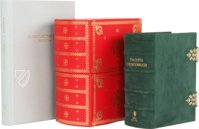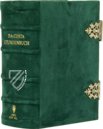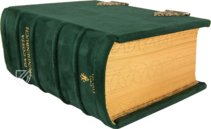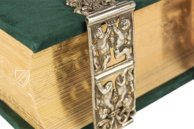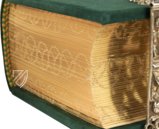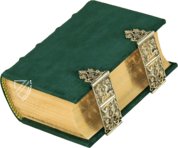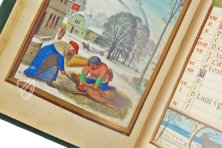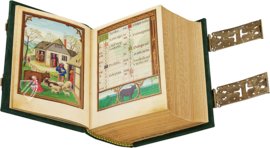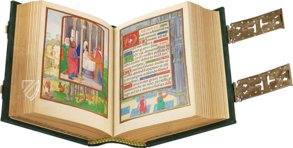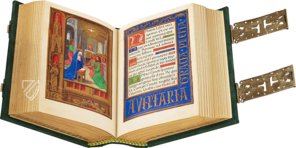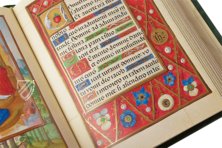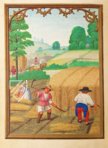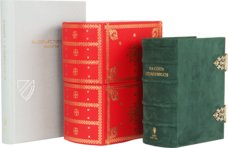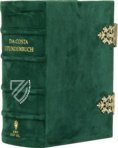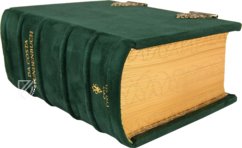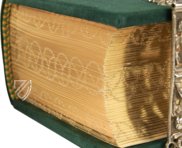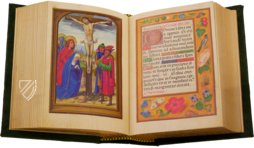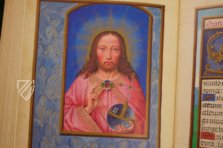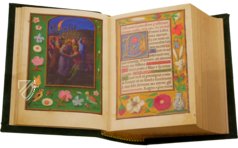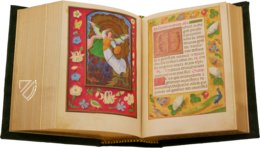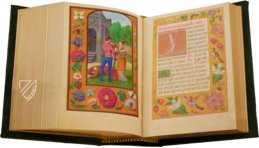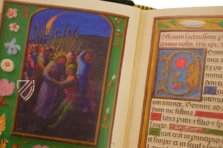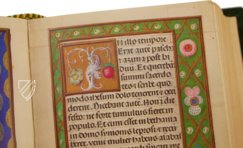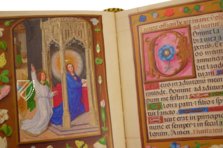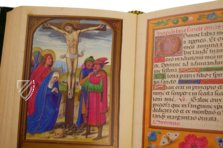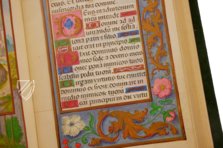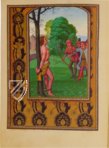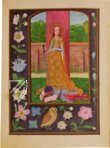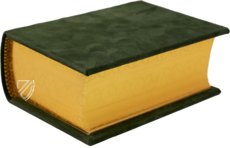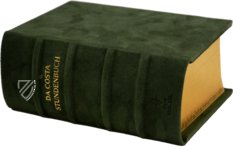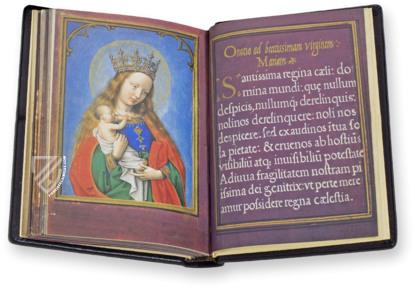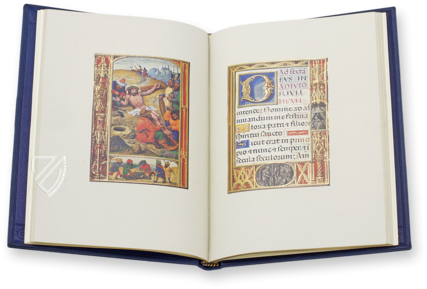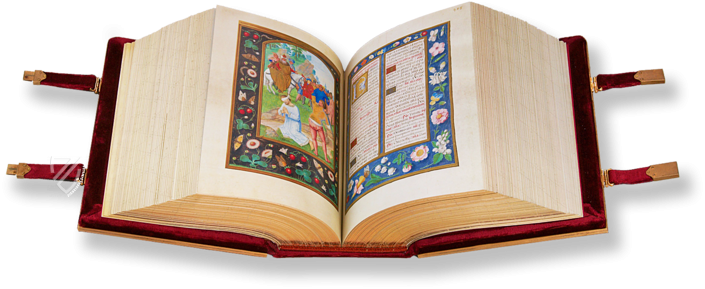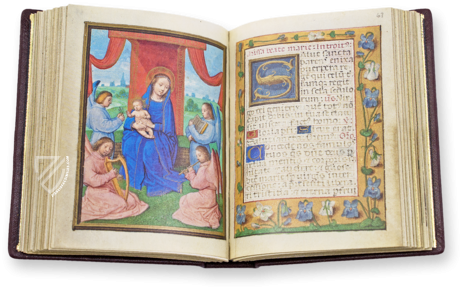Da Costa Hours
(3,000€ - 7,000€)
The final and most brilliant period of illuminated manuscript production was epitomized by the Ghent Bruges School and the all-star lineup of artists it produced – such as Gerard Horenbout or Gerard David. Yet, without a doubt the greatest master of them all is Simon Bening. The Da Costa Hours is probably the greatest early work of this exceptional artist. Featuring some 121 miniatures, including full-page calendar illustrations considered to be some of the finest of all time, this is considered to be an early masterpiece in the long and illustrious career of Simon Bening. The extraordinary manuscript has been owned by popes, kings, and industrial magnates throughout history, not without reason – including a full four centuries in the possession of the namesake Da Costa family in Portugal, who received the precious treasure as a gift from King Manuel I.
Da Costa Hours
Book illumination reached one of its greatest highpoints, and at the same time its apogee, in the fantastic art of the Ghent-Bruges school – with major artists such as Gerard Horenbout or Gerard David creating unforgettable masterpieces. Yet, without a doubt the greatest master of them all is Simon Bening, whose works marked both the climax and conclusion of the great Dutch tradition of book illumination. The Da Costa Hours is probably the greatest early work of this exceptional artist. While some of the 121 brilliant miniatures represent a critical synopsis of what book illumination had produced in the previous centuries, others offer a view of one the last great testimonies to the magnificent tradition of Dutch book illumination.
Simon Bening – a “Star” of his Time
Book illumination was probably already in his blood – after all, his father Alexander was a famous illuminator. A number of researchers have identified Alexander as the Master of the First Prayer Book of the Emperor Maximilian, and Simon’s uncle was the great painter Hugo van der Goes. Simon Bening was born around 1483 in Bruges or Antwerp; in 1508 he was admitted to the guild of book illuminators in Bruges – this was an indispensable requirement for anyone wishing to work as an artist in the outgoing Middle Ages. Nonetheless, he didn’t settle in Bruges prior to 1519: presumably he lived and worked at his father Alexander’s house. Alexander died in 1519. At the very same time Simon was being introduced into the art of illumination by his father he also discovered the works of other book illuminators such as Gerard Horenbout, with whom he went on to illustrate marvelous manuscripts. Simon Bening had become the undisputed 'star' on the illumination scene throughout Europe by about 1525 at the very latest – just like his contemporary Titian, incidentally, in panel painting. Yet even by 1510 or thereabouts he had already managed to establish a major reputation in Europe. His customers included no lesser a figure than Cardinal Albrecht of Brandenburg, one of the most important patrons of art in the 16th century who awarded commissions to major artists of his time such as Albrecht Dürer and Lucas Cranach the Elder.
A First-Class Resume
In 1530, the Portuguese diplomat and humanist Damião de Góis described Bening as being "the best master of book illumination in all Europe" –and was entirely right in this assessment. In addition to The Da Costa Hours, his masterpieces also include the Book of Hours for Cardinal Albrecht of Brandenburg (in private ownership), the Genealogical Tables of the Royal Houses of Spain and Portugal (London, British Library, Add. 12531), the Hennessy Book of Hours (Brussels, Bibliothéque royale, Ms. II. 158) and the Statutes of the Order of the Golden Fleece (Madrid, Instituto de Don Juan de Valencia). Just like Michelangelo and Titian, Bening went on to live a long life. In 1555 he was still paying his final subscriptions to the guild of book illuminators in Bruges at the age of 71 or 72. When he died in 1561 the great tradition of the Ghent-Bruges school died with him – forever.
Unique Artistry and Fantastic Creations
Bening’s profound knowledge of pictorial language was enormously important for the way he decorated the Da Costa Hours – particularly because the incredible number of miniatures meant that he needed to use a large number of compositional models. For instance, the codex required two cycles of pictures illustrating the Passion of Christ; the first eight for the Passion’s officium and a further four to depict the account of the Passion by the four Evangelists. Equally, the four Evangelists had to appear twice, the first time as authors of the biblical reports they had written and the second time in conjunction with their symbols. To meet these iconographic and compositional requirements Bening drew upon templates dating back to the time of Charles the Bold, the Last Duke of Burgundy. These templates had already been used by painters such as the Viennese Master of Mary of Burgundy. Yet Bening didn’t simply copy these templates, he completely redeveloped them and acquired a mastery that not even the original creators could ever have dreamed of achieving. To illustrate the point, for the nighttime scene of Christ being taken prisoner on folio 15v Bening used a depiction by the Master of the First Prayer Book of the Emperor Maximilian in the Flora book of hours as his template but dramatically darkened the scene: only a single torch lights the scene. The deep blue which dominates the scene is ideally complemented by the decorative border in green; the same green can also be found again on various parts of garments in the scene itself.
Exemplary Full-Page Calendar Miniatures
Bening’s attempt to design his landscape panoramas even more impressively is revealed in the 12 full page calendar miniatures that are some of the most famous and best examples of book illumination. Although great masters of the previous century such as the Limburg brothers and the Master of James IV of Scotland had already created tremendous calendar pictures, Bening perfected this genre in revolutionary fashion: the perspective he gives to the landscapes and the atmospheric design make these pictures stand out in the history of book illumination. One outstanding example, for instance, is folio 10v, the Labors of the Month of September. The combination of the foreground and center of the picture is already impressive in itself, yet the low valley, enveloped in a blue light, seems to stretch into infinity. And indeed the horizon bends realistically. This is the first time such a broadening expanse was depicted in this way.
The Ownership History
The Da Costa Hours is one of the first manuscripts to have been created by Simon Bening. His first dated work, the Imhof Book of Hours, is from 1511; our book of hours appeared in 1515 – and it is one of the first masterpieces to have been created for an Iberian customer. The coat of arms which was painted over on folio 1v has been ascribed to a member of the Sá family from Portugal. The emblem which has been painted over it, however, refers to the man after whom this particular book of hours has come to be named: Don Alvaro da Costa, armorer and treasurer to Manuel I, the King of Portugal who ruled from 1495 to 1521 and founded the Portuguese colonial empire. According to a history of the Da Costa family, in 1514 the manuscript was given as a present by Pope Leo X to King Manuel I who subsequently passed it on to Don Alvaro. The codex then remained in the possession of the Da Costa family for four centuries. In 1882 the manuscript was put on display in Lisbon by João Afonso Da Costa de Sousa Macedo e Albuquerque (1815–1890). After he died, the book of hours was inherited by his younger brother Luiz Antonio da Sousa Macedo e Albuquerque. It is at this point that we lose trace of our manuscript, which only reappears in 1905. It was now owned by the London-based antiquarian Bernard Quaritch. In the same year, he sold the manuscript on to a collector, George C. Thomas from Philadelphia. His successors went on to sell the codex to John Pierpont Morgan in 1910.
Codicology
- Alternative Titles
- Da Costa-Stundenbuch
- Size / Format
- 776 pages / 17.2 × 12.5 cm
- Origin
- Belgium
- Date
- Ca. 1515
- Epochs
- Style
- Genre
- Language
- Script
- Gothic Textura
- Illustrations
- 121 brilliant miniatures, many full-page, elegant decorative initials and frames with mostly floral motifs
- Content
- Liturgy of the Hours
- Patron
- Pope Leo X (1475-1521), born Giovanni di Lorenzo de' Medici
- Artist / School
- Simon Bening (ca. 1483–1561)
- Previous Owners
- King Manuel I of Portugal (1469-1521)
Don Álvaro da Costa (ca. 1470–1540)
Dom João Afonso Da Costa de Sousa Macedo, 1st Duke of Albuquerque (1815–90)
Bernard Alexander Christian Quaritch (1819–99)
George C. Thomas (1873–1932)
Da Costa Hours
Portrait of Luke the Evangelist
The great Simon Bening has depicted Luke the Evangelist writing in a 16th century bedchamber and styled as a Renaissance scholar seated upon a bull, his Evangelist symbol (both with halos). Fine strokes of gold ink have been used to highlight his cloak and its stylized fall of folds. Aside from being one of the Twelve Apostles and the first icon painter, Luke is credited with writing some of the most accurate and reliable works in the New Testament, making him both a historian and an artist.

Da Costa Hours
August: Harvesting Grain
In a field, two men harvest grain, one threshes it with a flail while the other reaps with a sickle. A woman is seen to the left binding the grain into sheaves. Over her shoulder, a cart drawn by two horses is stacked high with these sheaves and goes down a dirt road. A rolling green background reveals a building in the distance, a granary perhaps?
This is a splendid example of a calendar page, one of the specialties of Simon Bening, who elevated these “labors” from formulaic imagery to works of art resembling small panel paintings, as evidenced by the illusionistic wooden frame. Here the master reveals his talents in an ideal pastoral scene: the brightly-colored peasants appear to be clean and hardy while the land they work is bountiful and peaceful.

#1 Das Da Costa Stundenbuch (Deluxe Edition)
Language: German
Gregory T. Clark has provided an extensive scientific commentary. In it he reveals the origins and history of the manuscript, the historical context it was written in, and provides a detailed description of the miniatures, the pages with decorative initials and the entire artistic accoutrements.
(3,000€ - 7,000€)
#2 Das Da Costa Stundenbuch (Leather Edition)
Language: German
Gregory T. Clark has provided an extensive scientific commentary. In it he reveals the origins and history of the manuscript, the historical context it was written in, and provides a detailed description of the miniatures, the pages with decorative initials, and the entire artistic accoutrements.
(3,000€ - 7,000€)
- Treatises / Secular Books
- Apocalypses / Beatus
- Astronomy / Astrology
- Bestiaries
- Bibles / Gospels
- Chronicles / History / Law
- Geography / Maps
- Saints' Lives
- Islam / Oriental
- Judaism / Hebrew
- Single Leaf Collections
- Leonardo da Vinci
- Literature / Poetry
- Liturgical Manuscripts
- Medicine / Botany / Alchemy
- Music
- Mythology / Prophecies
- Psalters
- Other Religious Books
- Games / Hunting
- Private Devotion Books
- Other Genres
- Afghanistan
- Armenia
- Austria
- Belgium
- Colombia
- Croatia
- Cyprus
- Czech Republic
- Denmark
- Egypt
- Ethiopia
- France
- Germany
- Greece
- Hungary
- India
- Iran
- Iraq
- Israel
- Italy
- Japan
- Lebanon
- Luxembourg
- Mexico
- Morocco
- Netherlands
- Palestine
- Peru
- Poland
- Portugal
- Russia
- Serbia
- Spain
- Sri Lanka
- Sweden
- Switzerland
- Syria
- Turkey
- Ukraine
- United Kingdom
- United States
- Uzbekistan
- Aboca Museum
- Ajuntament de Valencia
- Akademie Verlag
- Akademische Druck- u. Verlagsanstalt (ADEVA)
- Aldo Ausilio Editore - Bottega d’Erasmo
- Alecto Historical Editions
- Alkuin Verlag
- Almqvist & Wiksell
- Amilcare Pizzi
- Andreas & Andreas Verlagsbuchhandlung
- Archa 90
- Archiv Verlag
- Archivi Edizioni
- Arnold Verlag
- ARS
- Ars Magna
- ArtCodex
- AyN Ediciones
- Azimuth Editions
- Badenia Verlag
- Bärenreiter-Verlag
- Belser Verlag
- Belser Verlag / WK Wertkontor
- Benziger Verlag
- Bernardinum Wydawnictwo
- BiblioGemma
- Biblioteca Apostolica Vaticana (Vaticanstadt, Vaticanstadt)
- Bibliotheca Palatina Faksimile Verlag
- Bibliotheca Rara
- Boydell & Brewer
- Bramante Edizioni
- Bredius Genootschap
- Brepols Publishers
- British Library
- C. Weckesser
- Caixa Catalunya
- Canesi
- CAPSA, Ars Scriptoria
- Caratzas Brothers, Publishers
- Carus Verlag
- Casamassima Libri
- Chavane Verlag
- Christian Brandstätter Verlag
- Circulo Cientifico
- Club Bibliófilo Versol
- Club du Livre
- CM Editores
- Collegium Graphicum
- Collezione Apocrifa Da Vinci
- Comissão Nacional para as Comemorações dos Descobrimentos Portugueses
- Coron Verlag
- Corvina
- CTHS
- D. S. Brewer
- Damon
- De Agostini/UTET
- De Nederlandsche Boekhandel
- De Schutter
- Deuschle & Stemmle
- Deutscher Verlag für Kunstwissenschaft
- DIAMM
- Droz
- E. Schreiber Graphische Kunstanstalten
- Ediciones Boreal
- Ediciones Grial
- Ediclube
- Edições Inapa
- Edilan
- Editalia
- Edition Deuschle
- Edition Georg Popp
- Edition Leipzig
- Edition Libri Illustri
- Editiones Reales Sitios S. L.
- Éditions de l'Oiseau Lyre
- Editions Medicina Rara
- Editorial Casariego
- Editorial Mintzoa
- Editrice Antenore
- Editrice Velar
- Edizioni Edison
- Egeria, S.L.
- Eikon Editores
- Electa
- Emery Walker Limited
- Enciclopèdia Catalana
- Eos-Verlag
- Ephesus Publishing
- Ernst Battenberg
- Eugrammia Press
- Extraordinary Editions
- Fackelverlag
- Facsimila Art & Edition
- Facsimile Editions Ltd.
- Facsimilia Art & Edition Ebert KG
- Faksimile Verlag
- Feuermann Verlag
- Folger Shakespeare Library
- Franco Cosimo Panini Editore
- Friedrich Wittig Verlag
- Fundación Hullera Vasco-Leonesa
- G. Braziller
- Gabriele Mazzotta Editore
- Gebr. Mann Verlag
- Gesellschaft für graphische Industrie
- Getty Research Institute
- Giovanni Domenico de Rossi
- Giunti Editore
- Graffiti
- Grafica European Center of Fine Arts
- Guido Pressler
- Guillermo Blazquez
- Gustav Kiepenheuer
- H. N. Abrams
- Harrassowitz
- Helikon
- Hendrickson Publishers
- Henning Oppermann
- Herder Verlag
- Hes & De Graaf Publishers
- Hoepli
- Holbein-Verlag
- Hortus Deliciarum
- Houghton Library
- Hugo Schmidt Verlag
- Idion Verlag
- Il Bulino, edizioni d'arte
- ILte
- Imago
- Insel Verlag
- Instituto Nacional de Antropología e Historia
- Istituto dell'Enciclopedia Italiana - Treccani
- Istituto Ellenico di Studi Bizantini e Postbizantini
- Istituto Geografico De Agostini
- Istituto Poligrafico e Zecca dello Stato
- Italarte Art Establishments
- J. Thorbecke
- Jan Thorbecke Verlag
- Johnson Reprint Corporation
- Josef Stocker
- Josef Stocker-Schmid
- Jugoslavija
- Karl W. Hiersemann
- Kasper Straube
- Kaydeda Ediciones
- Kindler Verlag / Coron Verlag
- Kodansha International Ltd.
- Konrad Kölbl Verlag
- Kurt Wolff Verlag
- La Liberia dello Stato
- La Linea Editrice
- La Meta Editore
- Lambert Schneider
- Landeskreditbank Baden-Württemberg
- Leo S. Olschki
- Les Incunables
- Library of Congress
- Libreria Musicale Italiana
- Lichtdruck
- Lito Immagine Editore
- Lumen Artis
- Lund Humphries
- M. Moleiro Editor
- Maison des Sciences de l'homme et de la société de Poitiers
- Manuscriptum
- Martinus Nijhoff
- Maruzen-Yushodo Co. Ltd.
- MASA
- McGraw-Hill
- Militos
- Millennium Liber
- Müller & Schindler
- Nahar and Steimatzky
- National Library of Wales
- Neri Pozza
- Nova Charta
- Oceanum Verlag
- Odeon
- Orbis Mediaevalis
- Orbis Pictus
- Österreichische Staatsdruckerei
- Oxford University Press
- Pageant Books
- Parzellers Buchverlag
- Patrimonio Ediciones
- Pattloch Verlag
- PIAF
- Pieper Verlag
- Plon-Nourrit et cie
- Prestel Verlag
- Princeton University Press
- Prisma Verlag
- Priuli & Verlucca, editori
- Pro Sport Verlag
- Propyläen Verlag
- Pytheas Books
- Quaternio Verlag Luzern
- Reales Sitios
- Recht-Verlag
- Reichert Verlag
- Reichsdruckerei
- Riehn & Reusch
- Roberto Vattori Editore
- Rosenkilde and Bagger
- Roxburghe Club
- Salerno Editrice
- Sarajevo Svjetlost
- Schöck ArtPrint Kft.
- Scolar Press
- Scrinium
- Scripta Maneant
- Scriptorium
- Siloé, arte y bibliofilia
- SISMEL - Edizioni del Galluzzo
- Sociedad Mexicana de Antropología
- Société des Bibliophiles & Iconophiles de Belgique
- Soncin Publishing
- Sorli Ediciones
- Stainer and Bell
- Studer
- Styria Verlag
- Sumptibus Pragopress
- Szegedi Tudomànyegyetem
- Taberna Libraria
- Tarshish Books
- Taschen
- Tempus Libri
- Testimonio Compañía Editorial
- Thames and Hudson
- The Clear Vue Publishing Partnership Limited
- The Facsimile Codex
- The Folio Society
- The Marquess of Normanby
- The Richard III and Yorkist History Trust
- Tip.Le.Co
- TouchArt
- TREC Publishing House
- TRI Publishing Co.
- Trident Editore
- Typis Regiae Officinae Polygraphicae
- Union Verlag Berlin
- Universidad de Granada
- University of California Press
- University of Chicago Press
- Urs Graf
- Vallecchi
- Van Wijnen
- VCH, Acta Humaniora
- VDI Verlag
- VEB Deutscher Verlag für Musik
- Verlag Anton Pustet / Andreas Verlag
- Verlag Bibliophile Drucke Josef Stocker
- Verlag der Münchner Drucke
- Verlag für Regionalgeschichte
- Verlag Styria
- Vicent Garcia Editores
- W. Turnowsky
- Waanders Printers
- Wiener Mechitharisten-Congregation (Wien, Österreich)
- Wissenschaftliche Buchgesellschaft
- Wydawnictwo Dolnoslaskie
- Xuntanza Editorial
- Zakład Narodowy
- Zollikofer AG

